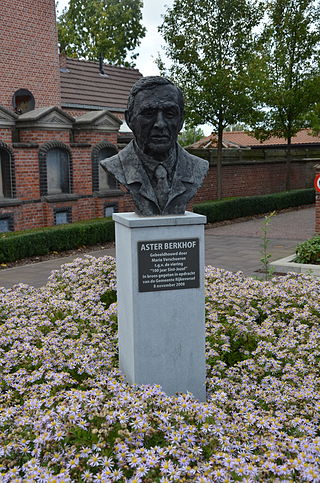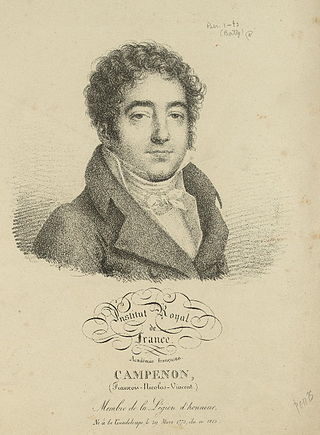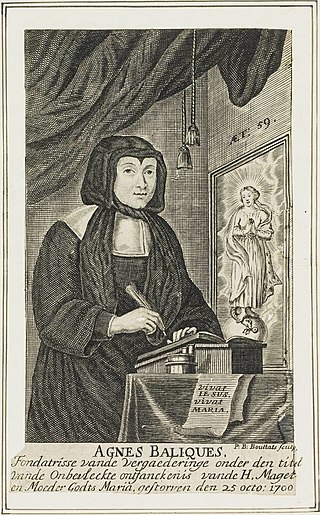
Jacob Buyens van Mol (died 12 June 1604) was a Flemish Dominican friar, priest and writer.

Jacob Buyens van Mol (died 12 June 1604) was a Flemish Dominican friar, priest and writer.
Jacob (French: Jacques) Buyens was born in Mol, in the Campine region of north-eastern Belgium. [1] [2] He entered the Dominicans in Antwerp and became a Roman Catholic priest. [1] He was a lecturer in theology and prefect of the Brotherhood of the Rosary. [1] He also distinguished himself as a preacher in his monastery. [1] [3] Buyens published Gheestelyke oeffeninghe om eenigheydt met Godt te cryghen and Den costelycken schadt der Broederschap van H. Roosen-Kransken van de aldereerweerdichste Moeder Godts in de Predic-heeren oorden ingestelt, printed in 12 volumes in Antwerp in 1600 by Hieronymus Verdussen and republished by the same printer in 8 volumes in 1614. In 1605 the work was published in Gothic letters by Corneille Verschueren. [1] [3] He then prepared material for an edition of the treatise De Reformatione Religiosorum by Jean Nider or Nyder. His premature death, however, did not allow him to complete this work, which was published in 1611 by P. Boucquet. [3] Buyens also left the manuscripts Vita B. Zegheri [1] (Vie du bienheurenx Zegher), written in Latin and kept in Lillers until the French Revolution, [3] and Vies de hommes illustres de l'ordre de Sain-Dominique en Angleterre, en Écosse, en Saxe et dan le Pays-Bas, written in Flemish. [3]
He died on 12 June 1604 in his convent in Antwerp. [1] He was buried in the cloister. [4]
The Remonstrants is a Protestant movement that split from the Dutch Reformed Church in the early 17th century. The early Remonstrants supported Jacobus Arminius, and after his death, continued to maintain his original views called Arminianism against the proponents of Calvinism. Condemned by the synod of Dort (1618–1619), the Remonstrants remained in a small minority in the Netherlands. In the middle of the 19th century, the Remonstrant Brotherhood was influenced by the liberal Dutch theological movement.

Max Rooses was a Belgian writer, literary critic, and curator of the Plantin-Moretus Museum at Antwerp.

Lodewijk Paulina Van Den Bergh, known as Lode Van Den Bergh, also using the pseudonyms Aster Berkhof and Piet Visser, was a Belgian writer.

François Nicolas Vincent Campenon was a French poet and translator from Latin and English.
Martin Morin was a French printer of incunables, active in Rouen between about 1490 and 1518. It has been suggested that he was born in or near Orbec around 1450, and died in Rouen around 1522. He learned the trade in the Rhine region where he was sent by the Rouen family Lallemant together with Pierre Maufer, and then became a printer and bookseller in Rouen. His 1492 Breviarium Saresberiense or Breviarium Sarum, a breviary for Salisbury, is said to be "the first recorded liturgical book printed for the English market".

Charles Monselet was a French journalist, novelist, poet and playwright, nicknamed "the king of the gastronomes" by his contemporaries. He specialised in comedic and romantic novels and his total output was around 40 volumes.
Joachim Trognaesius, sometimes Trognesius or Trogney, was a printer and bookseller in late-16th-century and early-17th-century Antwerp.
Arnout Coninx (1548–1617) was a printer and bookseller in the city of Antwerp from 1579 until his death in 1617. In 1586 he was fined for unlicensed printing, and in 1591 he was investigated for selling forbidden books. When the city of Antwerp had been reconquered for Philip II of Spain in 1585, Protestants had been given four years to settle their affairs and leave or be reconciled to the Catholic Church. Coninx waited until 1590, after the deadline had passed, to register his conversion to Catholicism.
Jean Le Laboureur was a French courtier, Roman Catholic clergyman and historian.
Louis-Émile Vanderburch was a 19th-century French writer and playwright. The painter Dominique Joseph Vanderburch (1722–1785) was his grandfather.
Isaac de Larrey, Sieur of Grandchamp and Courménil, born, according to some biographers 7 September 1638 in Lintot, near Bolbec and according to the majority, in Montivilliers, 25 January 1639 – 17 March 1719) was a French historian.
Jan van Blitterswyck was a Carthusian writer and translator in the Spanish Netherlands.

Guiliam or Willem Lesteens (1590–1661), Latinized Gulielmus Lesteenius, was a printer and publisher in the city of Antwerp, in the Spanish Netherlands.
Events in the year 1843 in Belgium.

Willem van Haecht, sometimes also Willem van Haecht the elder to distinguish him from the painter Willem van Haecht was a Flemish poet writing in the Dutch language. He was also a cloth merchant, draughtsman, a bookseller and publisher. He was a member since 1552 and from 1558 a factor of the chamber of rhetoric De Violieren in Antwerp. In that role he played an important part in the transition of the development of theatre in Flanders from plays mainly dealing with epic, moralising or allegorising themes towards plays expressing the humanist ideas of the Renaissance. He published the Psalms of the Bible in Dutch verse and also wrote poems and songs.
Jean-Jacques Courvoisier was a Minim Friar from the County of Burgundy and a spiritual author in the Spanish Netherlands.
Events in the year 1845 in Belgium.

Maria Petyt, also Petijt or Petiyt (1623–1677), was known as a "great mystic", Her writings have been cited as "unequaled in volume and mystical content within the historical context of the Flemish-speaking 17th century."

Agnes Baliques (1641–1700) was a Roman Catholic from Antwerp who founded the religious order of the Daughters of Our Lady of the Immaculate Conception, commonly known as the Apostolines.

Charles Petit-Dutaillis was a French medieval historian.